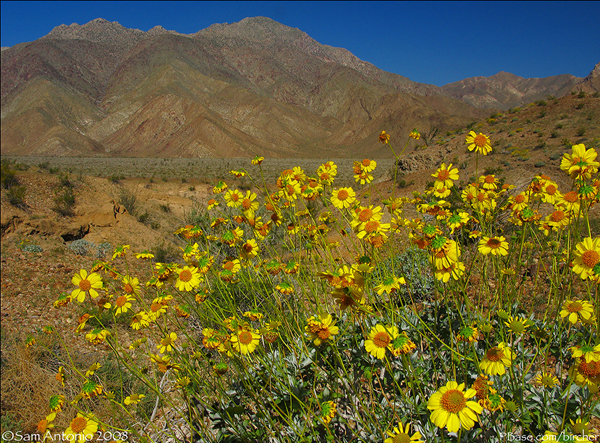Anza-Borrego North : Little Surprise Canyon

It would be very difficult to get lost here. When the canyon ends, which
is pretty fast as canyons go, the only thing you can do is retrace your
steps (unless of course you are part mountain goat). You walk south into
one of two forks of an erosion-forged canyon (the westward fork being recommended).
It's a desert garden walk that goes every-so-gently uphill. You can do it
in your tennis shoes.
Mostly, it's a place for looking at wildflowers. If flowers are in bloom
anywhere in the desert, you are likely to find them blooming here. Under
your feet you may notice plants like Erodium texanum, the native
Geraniaceae commonly known as Storksbill or Desert Filaree and
E. cicutarium, a non-native cousin with pretty blueish leaves,
but nevertheless a weed. Also growing underfoot are the blue flowers of
Phacelia distans, the tiny white flowers of a Cryptantha species
or two (bring your magnifying glass), and of course the ubiquitous Rock
Daisy, Perityle
emoryi.
As you wander up the trail, you will brush past the skinny green stalks of
the Desert Trumpet, the blue-green leaves (hopefully with yellow flowers)
of the Encelia fairinosa,
and the bright red flowers (most of the year) of the Chuparosa or Beloperone,
Justicia californica, which hummingbirds frequently visit. And, like
the bee in the photo above, you may wish to sample the aroma of the Desert
Lavender, Hyptis emoryi. No taking the nectar, however.
You shouldn't have to look too far off the trail toward the canyon walls
to spot the violet flowers of the Rose Mallow, Sphaeralcea ambigua
var. rosacea, a relative of the more commonly seen Apricot Mallow.
The walls of the canyon themselves are good places to look for the tall
stalks of the Heart-Leaf Evening Primrose, Camissonia cardiophylla,
with yellow flowers which turn a deep red as they mature.
Before turning around at the end of your walk up the canyon, be sure to take
notice of the high canyon walls. Notice how wind, the rain, and runoff from
the San Ysidro Mountains above have etched this very special place. Note also
that it faces north which means it gets shade every day and a certain amount
of protection from the wind, which translates to good growing conditions for
the flowers.
You will notice places where people have chosen to leave the canyon and climb
the canyon walls, but the real pleasure of this area lies in the canyon itself
and not its rim. There are better places to climb, such as the California
Riding and Hiking Trail to Culp Valley.
Getting to Little Surprise Canyon. From downtown Borrego
Springs, drive west on Palm Canyon Drive (County Road S-22) to the edge
of town. Follow S-22 left (south) on Montezuma Valley Road for half a mile
until you come to a large field on your right with an Anza-Borrego Desert
State Park kiosk and a building with restrooms. You will find trailheads
and plenty of room for parking in between. Check the map on the kiosk for
directions to the Little Surprise Canyon trailhead (it's just past the right
side of the restroom building) and also for other hiking possibilities.
|